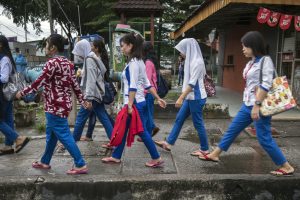In a recent United Nations poll of young people in South Asia, 78 percent said that climate change has impacted their studies. More girls reported that climate change affected their daily journey to school. For some, it is an existential threat. Zeeko, 19, put it simply when she told us that she sees its adverse effects every day in Maldives because her country is slowly sinking. Maldives is expected to disappear before the end of the century.
The upcoming United Nations Climate Change Conference (COP26) presents an opportunity for world leaders to put women and girls at the center of global efforts to adapt and build resilience to climate change. Based on the U.N. poll, 62 percent of young people said they believe that governments should prioritize climate action the most.
The climate and resource crises, as well as global inequality, have not disappeared during COVID-19. If anything, the pandemic has underscored the critical need to address gender inequality if we want to successfully combat the global pandemic and the climate crisis. It has also demonstrated the leadership roles that women and girls are playing in health and disaster response, especially at the local level.
COP20 established the first Lima work program on gender in 2014 to advance gender balance and integrate gender considerations into the implementation of the Climate Convention and the Paris Agreement. While there has been progress in promoting gender-responsive climate policy and action, there is still much to be done.
Today, climate plans, policies, and investments still do not adequately account for the distinct impacts of climate change on women, girls, and marginalized populations. Regardless of the sector – be it education, water, sanitation, or nutrition – it is very often women and girls who are expected to carry the increased burden caused by climate change, as well as the pandemic.
The Asia-Pacific region is particularly vulnerable to the impacts of climate change, due to both its geographic exposure to environmental shocks and stressors and underlying systemic social inequalities. This year’s COP26, hosted by the U.K. government, will center around climate change adaptation, mitigation, financing, and collaboration. But will there be space to discuss the challenges faced by those who are most impacted by the devastating effects of climate change and the COVID-19 pandemic?
There are three key things that need to be prioritized: first, gender-responsive climate finance; second, women and girls’ education for inclusive adaptation; and third, mainstreaming gender equality for climate resilience.
Women possess an extraordinary – and often underappreciated – potential to drive climate change mitigation and resource management efforts due to their influential roles in families and communities. Until recently, initiatives to empower women and adolescent girls as agents of change have remained woefully neglected in climate policy and finance circles.
We need to be intentional in addressing gender inequality and make women-focused investments to build their resilience to climate change.
The Asian Development Bank (ADB), for example, has been supporting climate-resilient infrastructure initiatives, in which women are not just beneficiaries but also the co-designers and co-implementors of projects. ADB is initiating the Community Resilience Partnership Program to support its developing member countries to scale up resilience investments that address the nexus between poverty, climate change, and gender, with a dedicated focus on advancing women-focused investments in resilience.
Women play a critical role in advancing climate investments, especially at the local level. They offer invaluable knowledge and capacity for identifying and addressing the underlying drivers of vulnerability in households, communities, and society. Increasing evidence from developing countries in Southeast Asia (e.g., Indonesia, the Philippines, and Vietnam) suggests that grassroots women’s organizations collaborate closely with local governments to use this knowledge and build their capacity to assess, prioritize, negotiate, and influence resource allocation for resilience investments targeted at vulnerable communities.
An enabling environment that can support policy dialogue, capacity development, and pilot projects will be critical to this inclusive approach and in making climate finance work for women. The EmPower program of UN Women not only enables women to be effective climate-smart entrepreneurs by focusing on training different stakeholders to mainstream gender in policies and programmes, but also provides ways for women entrepreneurs to gain access to funding that will allow their renewable energy-based enterprises to support climate-resilient livelihoods.
The transition to low carbon and green and resilient economies requires skill building and education, starting with girls and young women. UNICEF launched a report in 2020 that calls attention to the potential of Science, Technology, Engineering, and Mathematics (STEM) education to transform gender norms in the education system, to improve quality learning opportunities for girls, and to highlight key actions that can accelerate girls’ transition between education and technical expert jobs in STEM industries. In Bangladesh, Maldives, Nepal, and India, a Community of Action has shown how breaking the digital gender divide can unlock opportunities for adolescent girls in 21st-century economies.
Critically, STEM education also has the potential to contribute to girls’ and women’s empowerment, the transformation of communities and nations, and the construction of economies for the future.
Lastly, there is a need to revisit the nationally determined contributions of countries in Asia and the Pacific to ensure that women and girls are accounted for in policies for climate action. A recent UN Women report found that to enable rights-based and gender-transformative climate action, national development and climate change frameworks must recognize human rights and gender equality as core principles, including through mandating the roles and responsibilities of women in decision making. This means sectoral policies should integrate climate change, human rights, and gender equality objectives, in close collaboration between state and non-state stakeholders.
Indeed, global climate dialogues can lead to transformative action that can unlock fresh and diverse perspectives and innovative and practical solutions and finance. Women and girls are watching, with high hopes and critical concerns. COP26 is an opportune time and venue to provide much-needed momentum on gender responsive climate action.

































